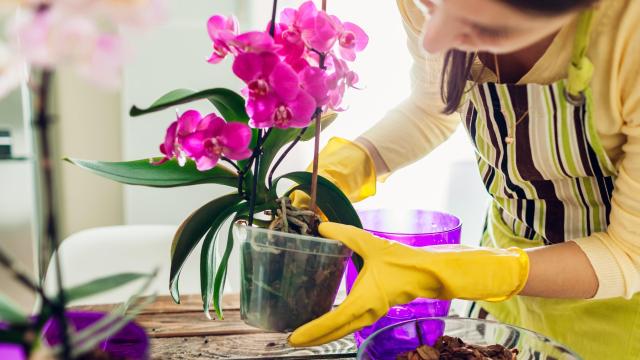Orchids are known for being tricky: They’re delicate, require watering and misting, and they need proper drainage and just the right amount of light. That level of plant care can be overwhelming, but once you’ve got a routine, you’ll knock it out of the park. Here’s how to care for an orchid in your home.
Orchids need the right kind of pot and potting mix
Orchids are epiphyte plants, basically meaning they don’t require soil; instead, the roots grasp onto trees and other surroundings. Since orchids are used to being out in the air with moving water and plenty of oxygen, you want to make sure you choose the right pot, like the rePotme carousel orchid pot and the mkono plastic pots for their ventilation holes and proper drainage.
Depending on the type of orchid, some thrive in bark chips, and others in moss. Orchids like Phalaenopsis and Cattleya thrive in pots with bark because they don’t retain water and give the roots the drainage it needs; other orchids, like lady slippers and nun’s orchids, flourish in moisture, making moss the best potting option.
Keep in mind when using bark chips that they tend to decompose and require changing. Better Homes and Garden recommends replacing bark chips every one or two years for them to maintain their draining capabilities.
How to water and fertilize your orchids
There are a few factors to consider when watering your orchids, including the time of year (orchids don’t need as much water in the winter as they do in the spring or summer), the climate (if the plant sees more sun or is often in a dry area of the house, you’ll need to water more often than in a more humid location), and your potting mix (moss is able to retain moisture much longer than bark, so watering once a week or when the moss starts to dry is best). In general, though, Costa Farms recommends soaking the orchid in a bowl of water once or twice a week or when the moss is dry to keep your orchid healthy and hydrated.
Orchids also need a fair amount of humidity, so misting daily is a good idea — that, or keeping the pot on top of gravel or small rocks that promote humidity. You can also keep orchids in the bathroom, which also can provide a lot of humidity. Above all else, make sure you follow a specific watering schedule for your specific kind of orchid.
Fertilizing is also essential for indoor orchids, and Just Add Ice warns that you’ll need to use the proper fertiliser strength. “Choose a fertiliser that contains equal amounts of nitrogen, phosphorus, and potassium (look for 20-20-20 on the label). Fertiliser should be used at half-strength, mixing it with an equal amount of water before applying it to your orchid.” They also recommend fertilizing orchids once or twice a month.
How much light does an orchid need?
According to Orchid Bliss, there are three things to consider when lighting your orchid: intensity, duration, and quality. As with all care instructions for orchids, the light it needs depends on the genus of the plant. Too little, and it won’t bloom; too much, and it gets sunburned.
If placed in a window, an east-facing one works best for equal light and shade. North-facing windows typically don’t offer enough light, and west-facing windows offer too much intensity. Take note of your surroundings and how the light comes into your home.
In terms of light quantity, orchids need a consistent amount. You may need to move your plant around the house depending on the season to maintain a regular light and dark schedule.
For light quality, orchids need the proper combination of red, green, far-red, and blue light, all of which the sun provides. If you’re growing with artificial light, Orchid Bliss recommends using fluorescent and LED lights to provide the full spectrum of light an orchid needs. Eventually, once you get into the habit of these plant rituals, it’ll feel like second nature, and you’ll have healthy orchids for years to come.

Leave a Reply
You must be logged in to post a comment.